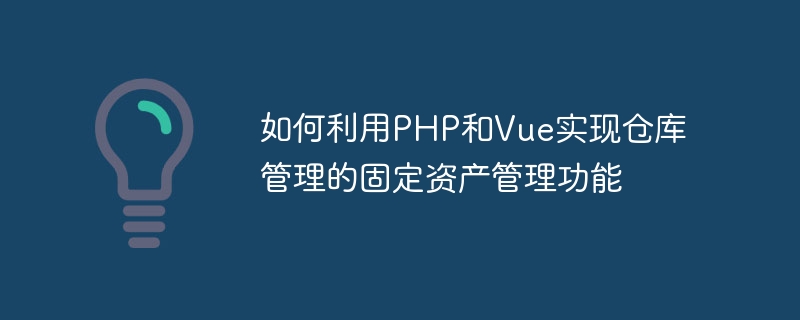

How to use PHP and Vue to implement the fixed asset management function of warehouse management
Introduction:
As the scale of enterprises expands, fixed asset management becomes a challenge faced by managers. an important task. As a place where a company's fixed assets are stored, the warehouse requires an efficient management system to manage and track fixed assets. This article will introduce how to use PHP and Vue to develop a simple but practical warehouse management system to realize the management function of fixed assets.
1. Technology Selection
When developing the warehouse management system, we chose to use PHP as the back-end language and Vue as the front-end framework. The main reason is that PHP has high flexibility and ease of use. Vue can provide good user interaction experience and interface effects.
2. Requirements Analysis
Let’s first clarify the requirements of the warehouse management system, which mainly include the following functions:
3. Project construction and configuration
4. Database design
Based on demand analysis, we designed the following database tables:
5. Back-end development
// Create a database connection
$mysqli = new mysqli('localhost ', 'root', 'password', 'database');
// Add fixed assets
function addAsset($data)
{
global $mysqli;
/ / Process the incoming parameters
$name = $mysqli->real_escape_string($data['name']);
$model = $mysqli->real_escape_string($data['model']);
$quantity = $mysqli->real_escape_string($data['quantity']);
// Perform insert operation
$sql = "INSERT INTO assets (name, model, quantity) VALUES ('$name', '$model', '$quantity')";
$result = $mysqli->query($sql) ;
// Return result
if ($result) {
return ['status' => 1, 'message' => '添加成功'];
} else {
return ['status' => 0, 'message' => '添加失败'];
}
}
// Delete fixed assets
function deleteAsset($id)
{
global $mysqli;
// Perform delete operation
$sql = "DELETE FROM assets WHERE id = '$id'";
$result = $mysqli->query($sql);
// Return result
if ($result) {
return ['status' => 1, 'message' => '删除成功'];
} else {
return ['status' => 0, 'message' => '删除失败'];
}
}
// Modify fixed assets
function updateAsset($id, $data)
{
global $mysqli;
// Process the incoming parameters
$ name = $mysqli->real_escape_string($data['name']);
$model = $mysqli->real_escape_string($data['model']);
$quantity = $mysqli-> ;real_escape_string($data['quantity']);
//Perform update operation
$sql = "UPDATE assets SET name = '$name', model = '$model', quantity = '$quantity' WHERE id = '$id'";
$result = $mysqli->query($sql);
// Return Result
if ($result) {
return ['status' => 1, 'message' => '修改成功'];
} else {
return ['status' => 0, 'message' => '修改失败'];
}
}
// Query fixed assets
function getAsset($ id)
{
global $mysqli;
// Execute query operation
$sql = "SELECT * FROM assets WHERE id = '$id'";
$result = $mysqli- >query($sql);
// Return results
if ($result && $result->num_rows > 0) {
// 获取查询结果 $data = $result->fetch_assoc(); return ['status' => 1, 'data' => $data];
} else {
return ['status' => 0, 'message' => '查询失败'];
}
}
...
// Add fixed assets
addAsset($_POST);
6. Front-end development
<h2>添加固定资产</h2>
<form @submit="addAsset">
<div>
<label for="name">名称:</label>
<input type="text" id="name" v-model="name">
</div>
<div>
<label for="model">型号:</label>
<input type="text" id="model" v-model="model">
</div>
<div>
<label for="quantity">数量:</label>
<input type="number" id="quantity" v-model="quantity">
</div>
<button type="submit">添加</button>
</form>